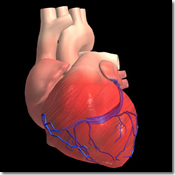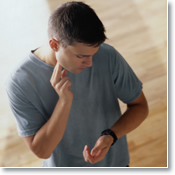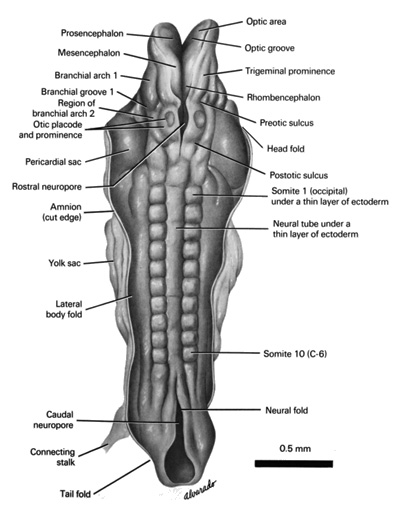Prenatal Form and Function – The Making of an Earth Suit
Unit 4: 3 to 4 Weeks
 Closer Look:
Closer Look:
 Applying the Science:
Applying the Science:
Vital Systems – The Beating Heart
Only 3 weeks and 1 day after fertilization - the heart begins to beat.1 By 4 weeks, the heart typically beats between 105 and 121 times per minute.2

Copyright © 2002 Lippincott, Williams & Wilkins.
All rights reserved.

Copyright © 2006 EHD, Inc. All rights reserved.

Hearing the Fetal Heartbeat

Doctors use several different methods to listen to the fetal heartbeat. About 3 weeks, one day after fertilization, when the heart first begins to beat, the sound of the little heart is too soft to hear. Very soon thereafter, they can see the motion using ultrasound technology.
A doctor's stethoscope is not sensitive enough to hear the embryo's heart beating.
A special stethoscope called a fetoscope works well when the fetus is larger, usually around 15-17 weeks.1 An active fetus however, can make this method of listening a bit challenging. Often when the fetoscope is finally in the right place on the woman's belly, her fetus will change positions and the doctor must move the stethoscope again in search of the fetal heartbeat.

The presence of a fetal heartbeat confirms pregnancy, as long as doctors are certain to distinguish the fetal heartbeat from the mother's. Usually this is not difficult as the fetus has a much faster heart rate than the mother. Sometimes during an examination, a woman's heart rate will increase and actually cause the fetal heart to beat more rapidly.
Noises from within can make the mother's and fetal heartbeat hard to distinguish.
1 F. Gary Cunningham, Paul C. MacDonald, Norman F. Grant, et al., Williams Obstetrics, 20th ed. (Stamford: Appleton and Lange, 1997), 30.

Between fertilization and birth, the heart beats approximately 54 million times, while over the course of an 80-year lifespan, the heart beats over 3.2 billion (3.2 × 109) times!3

All rights reserved.
Between 3 and 4 weeks, the body plan emerges as rapid growth of the relatively flat embryo - particularly that of the central nervous system, causes a dramatic folding of the embryo.4 This folding forms the chest and abdominal cavities and incorporates a portion of the yolk sac which becomes the lining of the digestive and respiratory tracts.5 Thus, development of the digestive system is underway just 4 weeks after fertilization.6
Upper and lower limb buds appear by four weeks.7 These buds are the first visible indication of the developing arms and legs. Specialized somites in the embryo’s back begin forming the dermis of the skin and the skeletal muscles, which are used for voluntary movement. These somites will also form the bones of the spinal column, skull, sternum, and ribs.8 Skeletal muscles eventually enable you to move your body.
A transparent sac called the amnion (am-ne-on) which was formed by 2 weeks, begins to surround the entire embryo by four weeks.9 Filled with amniotic (am-ne-ot’ik) fluid, this sterile liquid suspends and protects the developing embryo. This fluid also facilitates lung development, allows swallowing, and later provides nutrients.10








